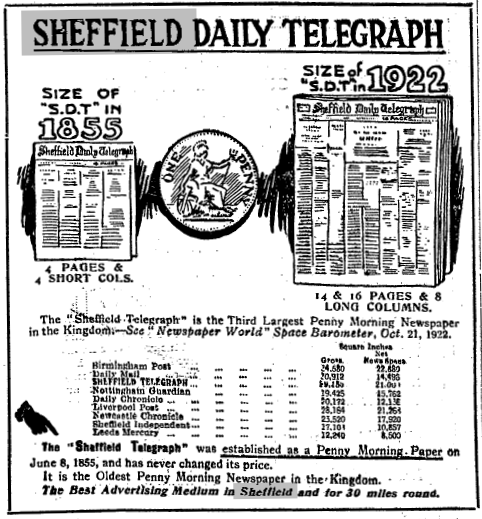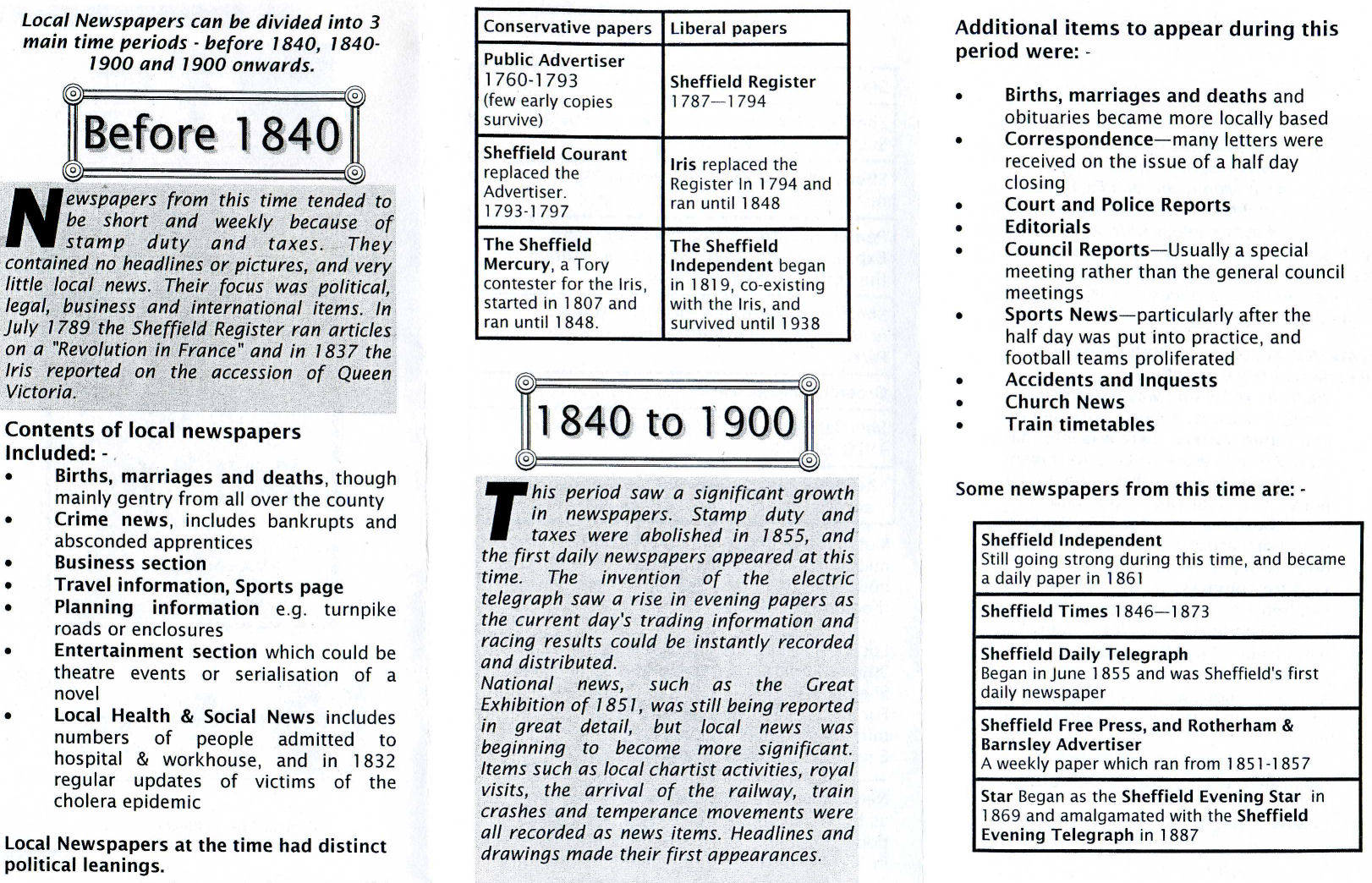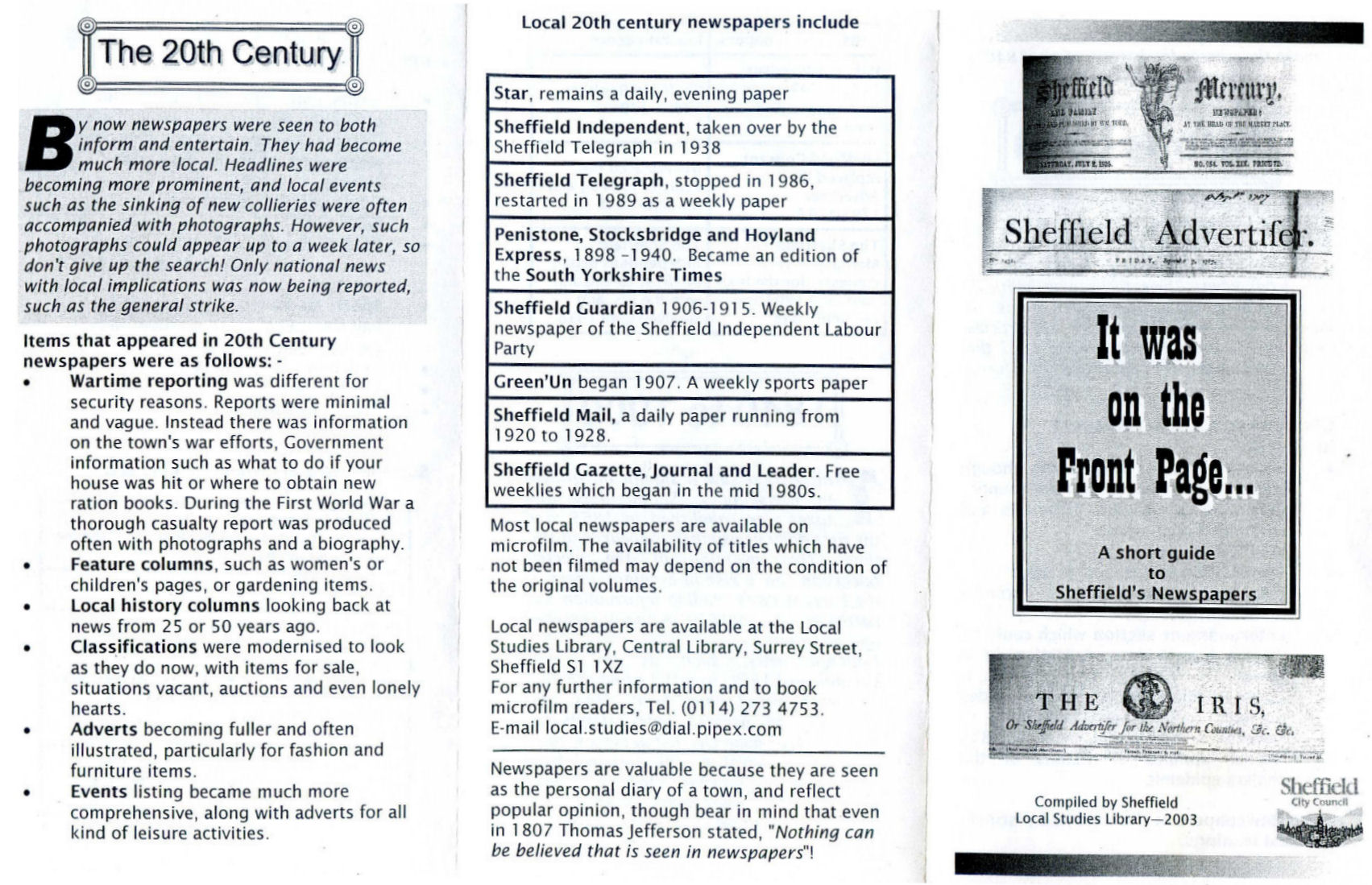
SHEFFIELD NEWSPAPERS
Sheffield Newspapers 1754 - 1978
The most succinct account of the history of Sheffield Newspapers appears in J E VICKERS book (1978) "A Popular History of Sheffield". As the Sheffield section of this site refers to both the local and the national press, I thought that it would be beneficial to post that page of the book as a point of reference.
"Prior to the advent of newspapers, what was happening in other parts of the
country and overseas could only be learned by the Sheffield people from
travellers, ballad singers, the town crier, sermons and printed broadsheets.
Though there was a number of attempts to start a newspaper in Sheffield before
1754, "Lister's Sheffield Weekly Journal" was the first to claim any success.
However, this newspaper only lasted just over a year before it was bought out by
the "Sheffield Weekly Register", which was printed in Doncaster. The year 1787
saw the first real Sheffield newspaper, when Joseph GALES began publication of
the "Sheffield Register", from his office and printing house in Hartshead.
Because of his strong political views which continually annoyed the local
authorities, GALES considered his safety threatened. He therefore decided to go
to America, his wife and children joining him later.
Before he fled, GALES had taken on a new clerk, James MONTGOMERY, and it was
left to MONTGOMERY to take over the newspaper, which he did in 1794. Deciding
that it would be safer to change the name of the newspaper, MONTGOMERY called it
the "Sheffield Iris" the latter word being Greek for
rainbow. The "Sheffield Iris" continued until bought by John BLACKWELL in 1825.
BLACKWELL being a bookseller who had shops in High Street and Norfolk Row.
In 1853 the "Sheffield Daily Telegraph" appeared for the first time, a Liberal
newspaper that appealed to the townsfolk dissatisfied with the other Sheffield
publications. The "Telegraph" was started by a Scot named BENSON, who
unaccountably sold it after only ten days to a printer called Joseph PEARCE. He
in turn gave up the newspaper in 1864 when competition from the "Sheffield and
Rotherham Independent" become too fierce. It was then bought by Frederick
CLIFFORD a London barrister, with WILLIAM LENG as editor. Thus began LENG's long
and momentous connections with Sheffield, which lasted
until his death in 1902.
So popular did the "Sheffield Telegraph" become that it was decided to produce
an evening edition to be known as the "Sheffield Evening Telegraph".
The first edition of this newspaper appeared on the streets on 7th June 1887.
For a short time there was keen rivalry by the owners of the "Independent", but
within a year the "Evening Star" had taken over and the "Evening Telegraph"
became the "Evening Telegraph and Star". Ten years later this name was again
changed to the "Yorkshire Telegraph and Star". A six page "Sports Special",
printed on green paper, (the forerunner of the "Green Un") was first published
in September 1907. In 1931 the "Sheffield Mail", a newspaper run by the owner of
the "Independent", was incorporated into the "Yorkshire Telegraph and Star".
This was followed, by the "Independent" being incorporated into the "Sheffield
Daily Telegraph" in 1938.
Just before the second world war, these newspapers came into the ownership of
Lord KEMSLEY and the names were then shortened to the "Sheffield
Telegraph" and "The Star". In 1959 the Thompson Organisation Ltd acquired the
Kemsley Group and from that time the "Star" was altered from its small
tabloid form to its present size. The two Sheffield newspapers again changed
hands in 1964, being taken over by the United Newspapers Ltd and in the
following year the "Sheffield Telegraph" became the "Morning Telegraph" as it is
today.
J E VICKERS book (1978) "A Popular History of Sheffield". (ISBN 0-906787-04-1)

SHEFFIELD NEWSPAPERS
Sheffield newspapers are available on microfilm at the Local Studies at the Central Library on Surrey Street in Sheffield.
Independent 1819 - 1938 (daily from 1861)
Established in December 1819 by Henry Andrew Bacon, The Sheffield Independent soon needed more capital, and two new partners, Thos. Asline Ward and Michael Ellison, came to the newspaper in December 1820. Robert Leader (1779-1861) purchased the newspaper in 1829. He maintained the Liberal political and commercial principles of the paper established in 1819. He was succeeded in the ownership by his son, Robert Leader (1809-85), who was editor and chief writer from 1833 until 1875. An expert shorthand writer and reporter of local events, he did much to widen the reputation of the paper in these years. His two sons, John Daniel (b.1835) and Robert Eadon (b.1839), entered into partnership with their father in January 1860. Robert (b.1860), the son of John Daniel, joined the company in January 1887.
The reduction in stamp duty by the Liberal Government in 1836 from 4d to 1d led to a meeting of nine proprietors of Yorkshire newspapers, at which it was decided to reduce the price of the newspapers from 7d to 4 1/2 d. On 17 September 1836, The Sheffield Independent first published at this price. After the removal of the penny stamp duty in 1855, the price of the paper reduced from 5d to 3 1/2 d; from 1 October 1861, the price was 1d, daily. The circulation figures rose accordingly: by 1838, a weekly average sale of the paper was 1,272; by 1842, the circulation was 2,596; by March 1857, the figure was 12,525; by 1882, it was 35,000
Iris 1794 - 1848 (began as the Sheffield Register)
Mercury 1806 - 1848
Star 1887 - present
Telegraph 1855 - 1986 (but now a weekly again) The Sheffield Telegraph was founded in 1855, and didn't become a daily until sometime between 1857 and 1862


An excellent Guide that was published in 2003 by Sheffield's Local Studies Library
There's a brief summary of the newspapers by Hugh Waterhouse at:
http://freepages.genealogy.rootsweb.com/~engsheffield/webpages/newspapers.htm

Last edition of the Morning Telegraph - 8th February 1986
In 1842 the main (weekly) papers were: The Sheffield and Rotherham Independent, The Iris and The Sheffield Mercury
All of these had a deaths column, but actual obituaries were rare. There are other papers which were not so long lived, such as the Sheffield Times. These papers are all held on microfilm by Sheffield Local Studies Library. Some of these, particularly the Iris and Mercury at the end of their publication period may have gaps.
Reading the article one person more than any stands out as a journalist and editor and that is William Leng
The following is from the Oxford Dictionary of National Biography
Sir William Christopher Leng
(1825–1902), journalist and newspaper proprietor, was born at Hull on 25 January
1825, the elder son of Adam Leng, a Hull businessman, and his wife, Mary,
daughter of Christopher Luccock, architect, of Malton. Sir John Leng (1828–1906)
was a younger brother. After education at a private school, where he showed a
taste for literature, Leng was apprenticed in 1839 to a wholesale chemist in
Hull, for whom he later worked as a commercial traveller before setting up his
own business in 1847.
Meanwhile in anonymous contributions to the Hull Free Press, including sketches
of notable citizens (published as a book in 1852), Leng campaigned vigorously
for practical measures of reform such as slum clearance and improved safety on
cargo vessels. He is credited with first suggesting to Samuel Plimsoll
(1824–1898) the crusade which led to the introduction of the Plimsoll line, as a
safeguard against overloading, following the Merchant Shipping Act of 1876.
Alienated by the self-interested opposition of prominent Hull Liberals to slum
clearance, Leng abandoned his original party affiliation and declared himself a
Conservative, a relatively painless transition in the era of Disraelian ‘tory
democracy’. Brought up as a Wesleyan Methodist, he joined the evangelical wing
of the Church of England.
In spite of Leng's and his brother John's divergent political opinions, Leng,
was a regular contributor of articles on municipal and national affairs to the
Dundee Advertiser, which his brother edited from 1851. In 1859 he gave up his
chemist's business in Hull and lived in Dundee until 1864, writing for the
Advertiser. During the American Civil War he was prominent among Scottish
journalists in supporting the cause of the north.
In 1864 Leng joined Frederick Clifford (1828–1904) in the purchase of the
Sheffield Daily Telegraph. He became its managing editor, and lived in Sheffield
for the rest of his life. As publishers, Leng & Co. invested boldly, purchasing
extensive new premises at Aldine Court in 1872 and installing linotype
machinery, at that time something of a novelty. The paper, which was almost
moribund when Leng took over, quickly became a great Conservative power in the
north of England. Its influence was sufficient to thwart Joseph Chamberlain's
parliamentary ambitions when he stood at Sheffield in 1874. As J. L. Garvin
later noted, the Telegraph at that time and under Leng's direction had become
‘the cleverest Conservative organ in the country’ (Koss, 1.219).
Leng was fearless in advocacy of what he deemed the public interest. In 1867, at
some personal risk, he denounced the intimidation of non-union labour by
Sheffield trade unionists under the leadership of William Broadhead (1815–1879),
inducing the government to appoint a royal commission of inquiry which fully
substantiated his allegations. He was the original of Mr Holdfast in Charles
Reade's Put Yourself in his Place (1870), a novel based on Broadhead's career.
In recognition of his services Leng was presented in April 1868 with his
portrait by H. F. Crighton and a purse of 600 guineas, subscribed by men of all
political opinions.
In the last quarter of the nineteenth century Leng's Sheffield-based newspaper
publishing business continued to expand; a Weekly Telegraph, a Sunday Telegraph,
and, most important, the Evening Telegraph and Star were added to his stable. He
remained active as a journalist, reporting descriptively for the Daily Telegraph
on his travels in Europe, and was active, too, in local politics, where he
served as vice-chairman and chairman of the Sheffield Conservative and
Constitutional Association. Leng was rewarded with a jubilee knighthood, awarded
on the recommendation of Lord Salisbury in 1887. Salisbury had a high regard for
the Sheffield Daily Telegraph, that ‘clever organ of Jingoism’ (Koss, 1.295).
In 1860 Leng married Anne (1833/4–1893), daughter of David Stark of Ruthven,
Forfarshire, and widow of Harry Cook of Sandhurst, Australia; her sister was
first wife of his brother John. His two sons, C. D. Leng and W. St Quentin Leng,
became partners in the Sheffield Telegraph. Leng died on 20 February 1902 at his
home, Oaklands, Collegiate Crescent, Sheffield, and was buried in Ecclesall
churchyard.
A. H. Millar, rev. Dilwyn Porter
Sources K. G. March, ‘The life and career of Sir William Leng: a study of the
ideas and influence of a prominent Victorian journalist’, MA diss., Sheffield
University, 1966 · In memoriam, Sir William Leng, kt (1902) · Sheffield Daily
Telegraph (20 Feb 1902) · Dundee Advertiser (20 Feb 1902) · W. Shepherdson,
Reminiscences in the career of a newspaper: starting a ‘daily’ in the provinces
(1876) · S. E. Koss, The rise and fall of the political press in Britain, 1
(1981)
Wealth at death £163,897 5s. 6d. (in UK): probate, 17 April 1902, CGPLA Eng. &
Wales
This page was last updated on 10/10/17 14:46